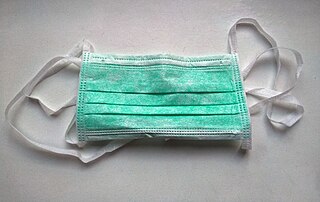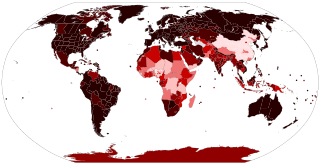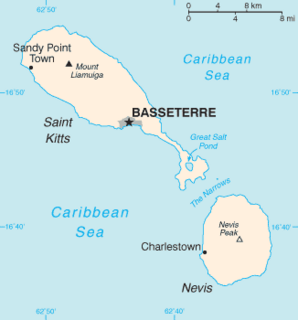
A surgical mask, also known as a procedure mask, medical mask or simply as a face mask, is intended to be worn by health professionals during procedures in surgery and nursing. It is designed to prevent infections in patients and treating personnel by catching bacteria shed in liquid droplets and aerosols from the wearer's mouth and nose. They are not designed to protect the wearer from inhaling airborne bacteria or viruses whose particles are smaller, and they are less effective than respirators, such as N95 or FFP masks, which provide better protection due to their material, shape and tight seal.

A respirator is a device designed to protect the wearer from inhaling hazardous atmospheres, including fumes, vapours, gases and particulate matter such as dusts and airborne microorganisms. There are two main categories: the air-purifying respirator, in which respirable air is obtained by filtering a contaminated atmosphere, and the air-supplied respirator, in which an alternate supply of breathable air is delivered. Within each category, different techniques are employed to reduce or eliminate noxious airborne contaminants.

The 2019–20 coronavirus pandemic is an ongoing pandemic of coronavirus disease 2019 (COVID‑19) caused by severe acute respiratory syndrome coronavirus 2 (SARS‑CoV‑2). The outbreak was identified in Wuhan, China, in December 2019. The World Health Organization declared the outbreak a Public Health Emergency of International Concern on 30 January, and a pandemic on 11 March. As of 3 May 2020, more than 3.5 million cases of COVID-19 have been reported in 187 countries and territories, resulting in more than 247,000 deaths. More than 1.12 million people have recovered.

Coronavirus disease 2019 (COVID-19) is an infectious disease caused by severe acute respiratory syndrome coronavirus 2 (SARS-CoV-2). The disease was first identified in December 2019 in Wuhan, the capital of China's Hubei province, and has since spread globally, resulting in the ongoing 2019–20 coronavirus pandemic. As of 3 May 2020, more than 3.5 million cases have been reported across 187 countries and territories, resulting in more than 247,000 deaths. More than 1.12 million people have recovered.

The presence of coronavirus disease 2019 (COVID-19) in Malaysia, part of the 2019–20 coronavirus pandemic, was first reported in January 2020 when it was detected on travellers from China arriving via Singapore on 25 January, following the outbreak of COVID-19 in Hubei, China. Reported cases remained relatively low and were largely confined to imported cases, until localised clusters began to emerge in March; the largest cluster was linked to a Tablighi Jamaat religious gathering held in Sri Petaling, Kuala Lumpur in late February and early March, leading to massive spikes in local cases and an exportation of cases to neighbouring countries. Within a few weeks, Malaysia had recorded the largest cumulative number of confirmed COVID-19 infections in Southeast Asia, breaching over the 2,000 mark in active cases by the end of March from fewer than 30 at the start of the month. By 16 March, the virus is reported in every state and federal territory in the country.

An outbreak of coronavirus disease 2019 (COVID-19), part of the 2019–2020 global pandemic, has been ongoing in Thailand since 13 January 2020, when the country made the first confirmation of a case outside China. Surveillance among incoming travellers revealed a small number of cases throughout January, almost all of whom were visitors or residents returning from China. The first reported local transmission was confirmed on 31 January. The number of cases remained low throughout February, with forty confirmed by the end of the month. Cases saw a sharp increase in mid-March, which was attributed to several transmission clusters, the largest of which occurred at a Muay Thai fight at the Lumpinee Boxing Stadium on 6 March. Confirmed cases rose to over a hundred per day over the following week, and public venues and businesses were ordered to close in Bangkok and several other provinces. Prime Minister Prayut Chan-o-cha declared a state of emergency, effective on 26 March. A curfew has been announced, effective since night of 3 April 2020.

The ongoing pandemic of coronavirus disease 2019, a novel infectious disease caused by severe acute respiratory syndrome coronavirus 2, spread to the United States in January 2020. The first U.S. case was identified on January 20, in a man who had returned from Wuhan, China to Snohomish County, Washington on January 15. The first report of a U.S. death came on February 29. An earlier U.S. death, on February 6, was determined in late April, and is believed to be community transmission. By the end of March, cases had occurred in all 50 U.S. states, the District of Columbia, and all inhabited U.S. territories except American Samoa. By April 11, the federal government approved disaster declarations for all states and inhabited territories except American Samoa. The same day, the U.S. death toll became the highest in the world when the number of cases reached 20,000, surpassing that of Italy. As of April 24, the U.S. death rate was 152 per million people, the tenth highest rate globally. On April 28, the total number of confirmed cases across the country surpassed 1 million, and by April 29, according to Johns Hopkins University at a minimum, 58,356 people had died as a result of COVID-19, more than the Americans who had died during the Vietnam War. As of May 3, 2020, the U.S. has the most confirmed active cases and deaths in the world.

An N95 mask or N95 respirator is a particulate-filtering facepiece respirator that meets the U.S. National Institute for Occupational Safety and Health (NIOSH) N95 classification of air filtration, meaning that it filters at least 95% of airborne particles. This standard does not require that the respirator be resistant to oil; another standard, P95, adds that requirement. The N95 type is the most common particulate-filtering facepiece respirator. It is an example of a mechanical filter respirator, which provides protection against particulates but not against gases or vapors.

The ongoing pandemic of coronavirus disease 2019, a novel infectious disease caused by severe acute respiratory syndrome coronavirus 2, soon spread to Hong Kong, and the first confirmed case was announced on 23 January 2020. Confirmed cases are generally transferred to Princess Margaret Hospital's Infectious Disease Centre for isolation and centralised treatment. On 5 February, only after a 4-day strike by front line medical workers did the Hong Kong government close all but three border control points – Hong Kong International Airport, Shenzhen Bay Control Point, and Hong Kong-Zhuhai-Macao Bridge Control Point remaining open. As of 25 April 2020, Hong Kong had 1,036 confirmed cases, 753 recovered cases and four death cases.

The ongoing pandemic of coronavirus disease 2019, a novel infectious disease caused by severe acute respiratory syndrome coronavirus 2, spread to Austria on 25 February 2020, when a pair of cases were confirmed. The cases involved a 24-year-old man and a 24-year-old woman who were travelling from Lombardy, Italy, and were treated at a hospital in Innsbruck.

The 2019–20 coronavirus pandemic was confirmed to have reached Bahrain in February 2020.
The 2019–20 coronavirus pandemic was confirmed to have reached Liberia in March 2020.

The 2020 coronavirus pandemic in the Bahamas is part of the 2019–20 coronavirus pandemic of coronavirus disease 2019 (COVID-19). The outbreak was identified in Wuhan, China, in December 2019, declared to be a Public Health Emergency of International Concern on 30 January 2020, and recognized as a pandemic by the World Health Organization on 11 March 2020. It was confirmed to have reached the Bahamas on 15 March 2020 with the announcement of the first case.

Workplace hazard controls for COVID-19 are the application of occupational safety and health methodologies for hazard controls to the prevention of coronavirus disease 2019 (COVID-19). The proper hazard controls in the workplace depend on the worksite and job task, based on a risk assessment of sources of exposure, disease severity in the community, and risk factors of individual workers who may be vulnerable to contracting COVID-19.
Medical materials and other goods shortages caused by the 2019–20 coronavirus pandemic quickly became a major issue of the pandemic. The matter of pandemic-related shortage has been studied in the past and has been documented in recent events. On the medical side, shortages of personal protective equipment such as medical masks, gloves, face shields, gear, sanitising products, are also joined by potential shortage of more advanced devices such as hospital beds, ICU beds, oxygen therapy, ventilators and ECMO devices. Human resources, especially in terms of medical staff, may be drained by the overwhelming extent of the epidemic and associated workload, together with losses by contamination, isolation, sickness or mortality among health care workers. Territories are differently equipped to face the pandemic. Various emergency measures have been taken to ramp up equipment levels such as purchases, while calls for donations, local 3D makers, volunteer staffing, mandatory draft, or seizure of stocks and factory lines have also occurred. Bidding wars between different countries and states over these items are reported to be a major issue, with price increases, orders seized by local government, or cancelled by selling company to be redirected to higher bidder. In some cases, medical workers have been ordered to not speak about these shortages of resources.

The 2020 coronavirus pandemic in Turks and Caicos Islands is part of the ongoing global viral pandemic of coronavirus disease 2019 (COVID-19), which was confirmed to have reached the British Overseas Territory of the Turks and Caicos Islands on 23 March 2020, and the first death occurred on 5 April 2020.

The 2020 coronavirus pandemic in Saint Kitts and Nevis is part of the ongoing global viral pandemic of coronavirus disease 2019 (COVID-19), which was confirmed to have reached Saint Kitts and Nevis on 24 March 2020.

A cloth face mask is a mask made of common textiles, usually cotton, worn over the mouth and nose. Unlike surgical masks and respirators such as N95 masks, they are not subject to regulation, and there is currently little research or guidance on their effectiveness as a protective measure against infectious disease transmission or particulate air pollution.
An FFP mask is a type of protective mask certified by the European Union that serves to protect against particulates such as dust particles and various viruses in the air. The EN 149 standard defines three classes of filter efficiency for these masks, namely FFP1, FFP2 and FFP3. It is an example of a mechanical filter respirator.

The first COVID-19 case was confirmed in Philadelphia, Pennsylvania, in March 2020. By April, Philadelphia was the worst-affected part of the state during the 2020 coronavirus pandemic in Pennsylvania.
![Taiwan President Tsai Ing-wen wearing a mask. 04.02 Zong Tong Shi Cha [Zhong Yang Liu Xing Yi Qing Zhi Hui Zhong Xin ] 49726568957 66543b616e o.jpg](http://upload.wikimedia.org/wikipedia/commons/thumb/3/38/04.02_%E7%B8%BD%E7%B5%B1%E8%A6%96%E5%AF%9F%E3%80%8C%E4%B8%AD%E5%A4%AE%E6%B5%81%E8%A1%8C%E7%96%AB%E6%83%85%E6%8C%87%E6%8F%AE%E4%B8%AD%E5%BF%83%E3%80%8D_49726568957_66543b616e_o.jpg/440px-04.02_%E7%B8%BD%E7%B5%B1%E8%A6%96%E5%AF%9F%E3%80%8C%E4%B8%AD%E5%A4%AE%E6%B5%81%E8%A1%8C%E7%96%AB%E6%83%85%E6%8C%87%E6%8F%AE%E4%B8%AD%E5%BF%83%E3%80%8D_49726568957_66543b616e_o.jpg)









![The government of Taiwan instituted a mask rationing system. With population of 24 million, Taiwan has been producing more than 10 million masks per day since March. 02.05 Zong Tong Fang Shi [Tai Wan Kang Jiang Zhi Zao Gong Si ] (49491845167).jpg](http://upload.wikimedia.org/wikipedia/commons/thumb/2/24/02.05_%E7%B8%BD%E7%B5%B1%E8%A8%AA%E8%A6%96%E3%80%8C%E5%8F%B0%E7%81%A3%E5%BA%B7%E5%8C%A0%E8%A3%BD%E9%80%A0%E5%85%AC%E5%8F%B8%E3%80%8D_%2849491845167%29.jpg/440px-02.05_%E7%B8%BD%E7%B5%B1%E8%A8%AA%E8%A6%96%E3%80%8C%E5%8F%B0%E7%81%A3%E5%BA%B7%E5%8C%A0%E8%A3%BD%E9%80%A0%E5%85%AC%E5%8F%B8%E3%80%8D_%2849491845167%29.jpg)

















